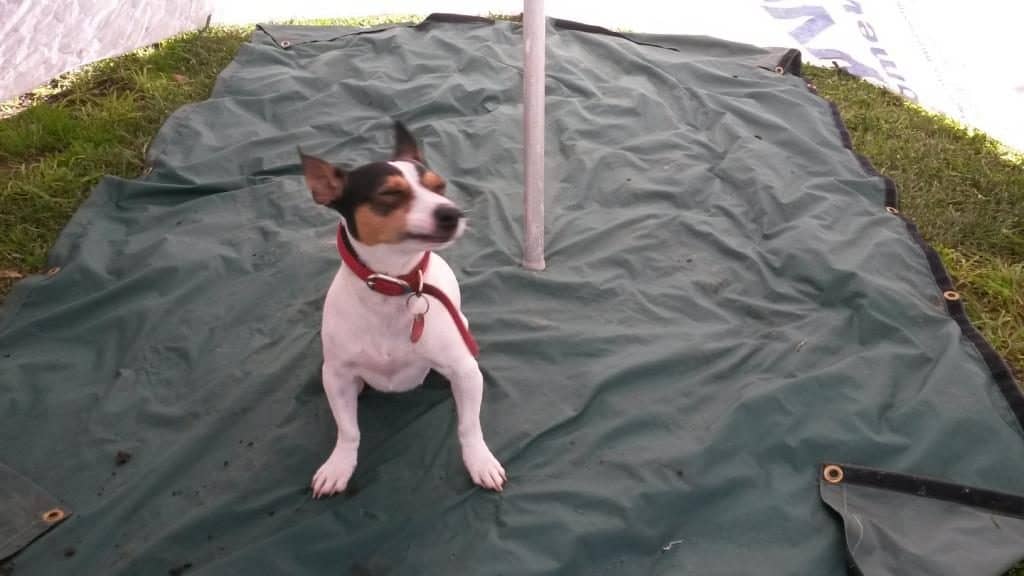I thought I would make a slightly smaller ‘Decagon’ tent. It turned out to be over 250 grams lighter than the original model. See: http://www.theultralighthiker.com/new-decagon-octagon-tyvek-igloo-tent-design/)
It makes a tent which is still over 9’ x 7’6” (270 cm x 225cm) inside and 5’2” (155cm) high at the apex and 40” (1 metre) at the door. It is wide enough for two to sleep sideways but long enough for two to sleep lengthways too. Roof only weight: 607 grams complete with guys, tie-outs, etc in Tyvek Homewrap weighed this afternoon on my kitchen scales. The new (1 oz/yd2) silnylon poncho floor (http://www.theultralighthiker.com/hole-less-ponchoshelter/) will weigh approx 130 grams. You will need 10 x (eg) Vargo Shepherd’s Hook stakes (http://www.theultralighthiker.com/tent-stakes-and-tricks/) to set it up (80 grams). Total weight: 817 grams. This is more than satisfactory for such a large area.
Another change I made to this tent is cutting off 1’ from the doorway arch and adding closeable storm flaps which overlap at the top and join at the bottom. This will make the tent enormously more waterproof in really bad weather. It also means that it can be set up as a decagonal tipi with one corner high enough off the ground you can just wriggle in underneath.
I will be making a 1oz/yd2 silnylon model. I anticipate the roof will be under 350 grams, plus 130 grams for the poncho and 80 grams for the pegs = 560 grams! As I will be making one for an anticipated Qld rainforest hiking trip I will be sewing in a 1.35 oz/yd 2 silnylon floor and .7 oz/yd2 insect netting. I figure this will not add more than another 100 grams (if that), so a total of eg 650 grams! It will also cost me only about $100.
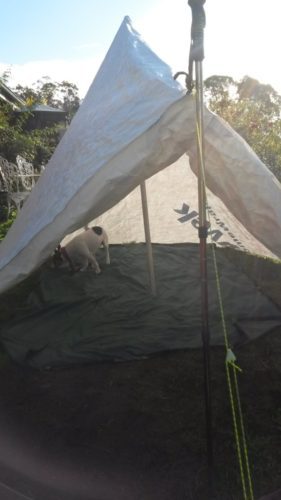
Fully open mode: Spot checking it out.
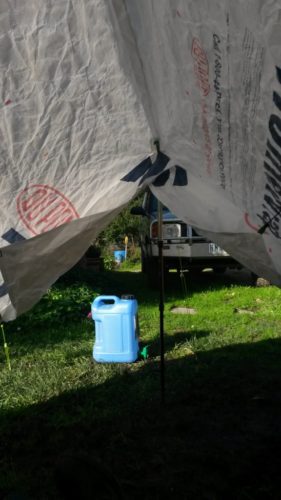
View looking out. You would normally have a fire about where the 10 litre drum is.
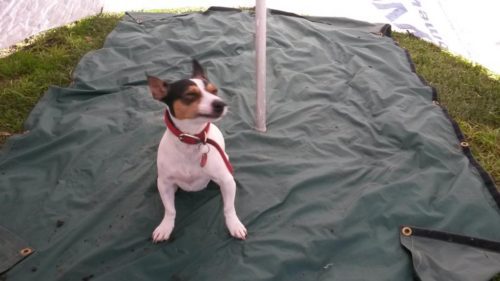
Spot’s ‘seal of approval’. That’s a 5′ x 7′ (150 cm x 210 cm) poncho tarp lying on the floor with plenty of room to spare!.
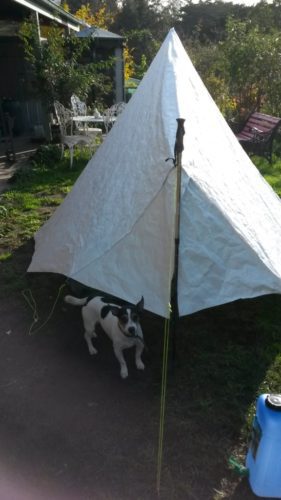
Storm mode with doors closed. Still 1′ (30 cm) of ventilation at the bottom, or room for a dog to go in and out.
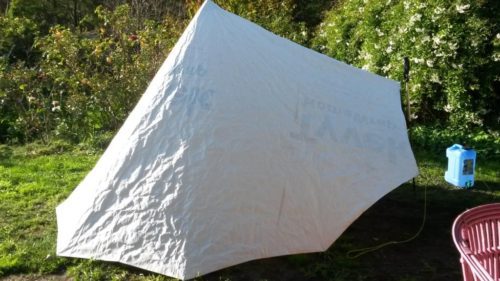
Side view.
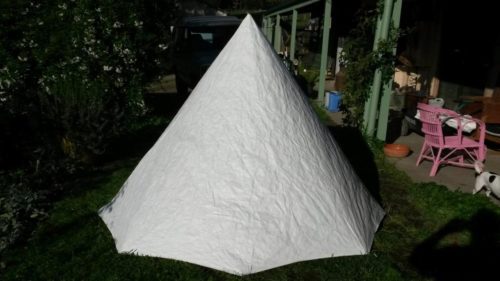
Rear view: the wind will go right round this tent.
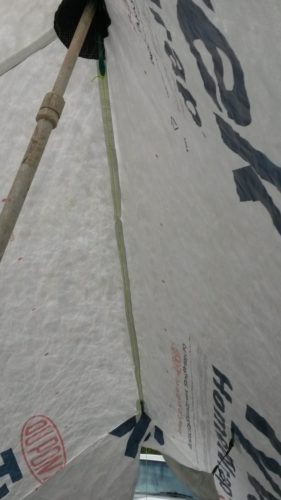
Clothesline along the front ridgeline (yellow cord).
NB the Dyneema tent pole reinforcement. I just cut a circle of Dyneema and sewed it on after I had joined the two pieces of Tyvek together (roughly a half circle (7 slices) and a quarter (3 slices). I then cut the slice of Dyneema I didn’t need out and sewed the two edges of the tent together to make the tipi shape. NB: Leave eg @ 1” extra to all your pieces for joining – likewise at least ½” for a hem around the bottom.
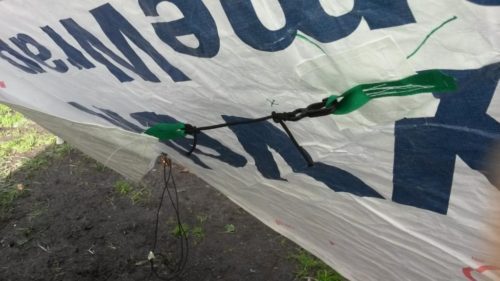
The ‘doors’ just hook back to loops sewn into the walls. To close, wrap hook around hiking pole and hook onto itself. No zips.
Setting up: Use a carabiner to join the two corners either side of the door arch together. Now it is an octagon. Pin out the corner opposite the door, then the two either side of that corner. They will be slightly forward of it. Then insert the centre pole. Attach the other pole and peg it straight out (You can move it later). The tent will now stand up by itself. Starting at the back go around pegging all the corners out. When you get to the two either side of the door remove the carabiner from one loop. A little adjustment may be needed to get all the corners standing taut. It is the second easiest tent to put up I have ever owned. The even easier one is: http://www.theultralighthiker.com/the-deer-hunters-tent/
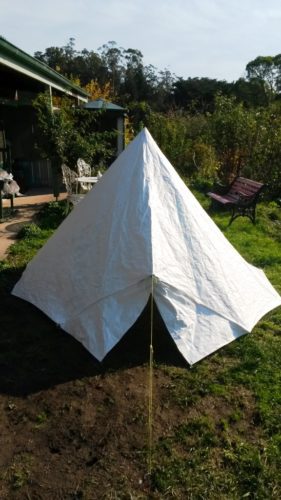
In really bad weather – or if there is a crowd – the tent also sets up as a decagon. One corner is about 1’ off the ground where you can crawl in. The decagon makes a tipi style tent which is @ 10’6″ x 8’6″in (320 x 260 cm) a huge area, probably enough in an emergency to sleep seven!.
When hunting I will usually just break a couple of bush sticks for the poles, one 5’ 2” (155cm) tall, the other about a 40” (1 metre) – or I can use our hiking poles if hiking.
This is really a lovely tent and was fun to make. You should have a try at one. If you can’t get your hands on some Tyvek, you could make it very cheaply out of a couple of blue poly tarps (not so fireproof though!).
As usual, make one of these for your own use but if you want to manufacture them, I would like some credit – and some cash, please!
See it in action here: http://www.theultralighthiker.com/wonnangatta-waterford-to-angusvale-day-one/
PS: I finally made this tent in Silnylon (the Siligloo 379 grams), and I made a floor for it as well (though I could still use the Pocket Poncho Tent (185 grams) as a floor. All these are developments of these Tyvek prototypes. Making tents and shelters yourself is a fun hobby which you can get into by just buying a 30 metre by 3 metres wide roll of Tyvek (Bunnings will get it in) for under A$200 – enough to make perhaps half a dozen or more interesting projects.
See also:
https://www.theultralighthiker.com/2017/08/10/the-pocket-poncho-tent/
https://www.theultralighthiker.com/2017/12/30/the-siligloo/
http://www.theultralighthiker.com/new-decagon-octagon-tyvek-igloo-tent-design/
http://www.theultralighthiker.com/honey-i-shrank-the-tent/.
http://www.theultralighthiker.com/the-deer-hunters-tent/.
http://www.theultralighthiker.com/does-spot-like-to-hunt-deer/
http://www.theultralighthiker.com/tyvek-solo-fire-shelter/
http://www.theultralighthiker.com/tyvek-tent-designs/
http://www.theultralighthiker.com/tyvek-twin-fire-shelter/
http://www.theultralighthiker.com/one-pole-tyvek-tipi/
http://www.theultralighthiker.com/tyvek-bivi/
http://www.theultralighthiker.com/new-tyvek-forestertent-design/
http://www.theultralighthiker.com/tyvek-jack-russell-rain-coat-13-grams/

